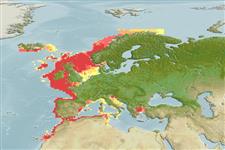Classification / Names
Common names from other countries
Main reference
Size / Weight / Age
Max length : 120 cm TL male/unsexed; (Ref. 35388); 111.0 cm TL (female)
Length at first maturity
Lm ?, range 75 - ? cm
Environment
Marine; bathydemersal; depth range 30 - 550 m (Ref. 4426)
Climate / Range
Deep-water, preferred 9°C (Ref. 107945); 72°N - 27°N, 24°W - 34°E
Distribution
Eastern Atlantic: Murmansk in Russia, Norway, southern Iceland, the Faroes, northern North Sea and Skagerrak to northern Morocco, including western Mediterranean and the Madeira Islands.
Countries | FAO areas | Ecosystems | Occurrences | Introductions
Short description
Dorsal
spines
(total): 0;
Anal
spines: 0;
Anal
soft rays: 0. Snout pronounced, rather pointed; disc rhomboid, with angled outer corners upper surface entirely spinulose, underside prickly on large areas; about 8 thorns usually in a complete row around inner margin of eye, small thorns on scapular, generally a row of about 50 thorns on each side of midline from shoulder to first dorsal fin; upper surface plain ashy-grey, underside white (Ref. 3167).
IUCN Red List Status (Ref. 115185)
Threat to humans
Harmless
Human uses
Fisheries: minor commercial
More information
Age/SizeGrowthLength-weightLength-lengthLength-frequenciesMorphometricsMorphologyLarvaeLarval dynamicsRecruitmentAbundance
ReferencesAquacultureAquaculture profileStrainsGeneticsAllele frequenciesHeritabilityDiseasesProcessingMass conversion
Tools
Special reports
Download XML
Internet sources
Estimates of some properties based on models
Phylogenetic diversity index
PD50 = 0.5000 many relatives (e.g. carps) 0.5 - 2.0 few relatives (e.g. lungfishes)
Trophic Level
3.5 ±0.37 se; Based on food items.
Resilience
Low, minimum population doubling time 4.5 - 14 years (Assuming tm>5)
Vulnerability
High to very high vulnerability (66 of 100)
Price category
